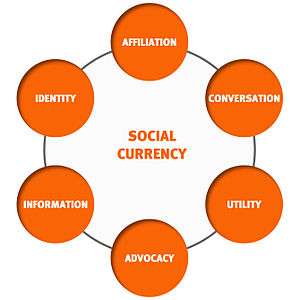Social currency
Social currency is a common term that can be understood as the entirety of actual and potential resources which arise from the presence in social networks and communities, may they be digital or offline. It derives from Pierre Bourdieu’s social capital theory and is about increasing one’s sense of community, granting access to information and knowledge, helping to form one’s identity, and providing status and recognition.
Social currency in Marketing and Management
In their study on social currency, the consulting company Vivaldi Partners defined social currency as the extent to which people share the brand or information about the brand as part of their everyday social lives at work or at home. This sharing helps companies to create unique brand identities and earn permission to interact with consumers or customers. In today’s age, building social currency is an important investment companies can make to create value for themselves. Social Currency moves social initiatives and campaigns beyond marketing and communications efforts to impacting and changing entire industries and categories. Consumers and customers will benefit as well as they increasingly participate in social platforms, and use social technologies.[1]
Social currency can be divided into six dimensions or levers:
It is about creating a sense of community and by that a strong affiliation between customers, consumers and users of a brand. Having social currency increases a brand’s engagement with consumers and interaction with customers, and by that adding to the customer conversation around the brand, it grants access to information and knowledge, which is being shared within the customer base. Belonging to a group also helps users of a brand to grow personally by accessing new utility and also developing their own identity in the respective peer group. A strong attachment to a brand will also be a core driver for an active advocacy recommending or even defending the brand.

The Social Currency Wheel is an alternative to the traditional brand funnel or customer decision journey. The Social Currency Wheel evaluates the impact of social behaviors of customers on social currency and three outcomes: consideration, purchase, and loyalty.[2] The goal of the Social Currency Wheel is to explain how customers’ social processes and behaviors drive each of the conversions. Marketers can engage with customers during these social processes and behaviors, and influence the outcomes.
Further examples of social currency
Social currency is information shared which encourages further social encounters. It can be a factor in establishing fans of sports or television programmes.[3] As well as talking about sports, attendance at sports events themselves is a form of social currency. Young men in particular feel the need to learn about sporting current events in order to facilitate social interaction. However these types of fan can easily move to a new sport, team, or programme in the future if the new one offers more social currency.[4] Women may use jewellery and clothes as part of their social currency, providing a way into communication.[5]
References
- ↑ "Social Currency Study" (PDF). Retrieved 1 July 2011.
|first1=missing|last1=in Authors list (help) - ↑ http://vivaldipartners.com/vpsocialcurrency/sc2012
- ↑ Hoover, Stewart M. (2001). "Visual religion in media culture". In David Morgan, Sally M. Promey. The Visual Culture of American Religions. University of California Press. p. 154. ISBN 9780520225220. Retrieved 2014-02-26.
- ↑ The Elusive fan
- ↑ Marketing to Women